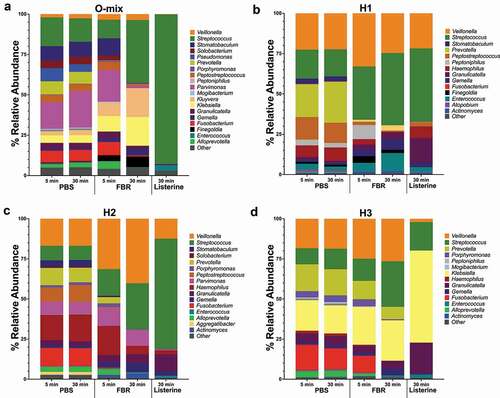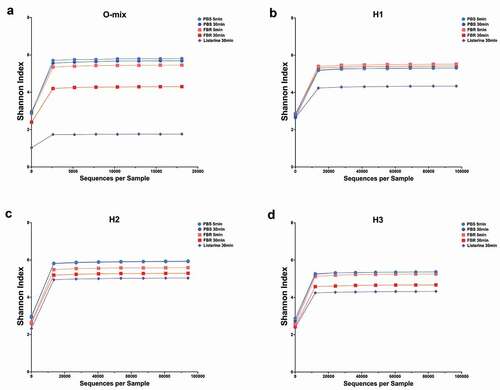Figures & data
Table 1. Species and strains and their growth conditions
Table 2. Activity of fresh breath rinse against common oral species in monoculture
Figure 1. The test mouthrinse antimicrobial activity against common oral species in monoculture. Single-species cultures of Fusobacterium periodonticum, F. nucleatum, Prevotella intermedia, Tannerella forsythia, Veillonella atypica, Porphyromonas gingivalis, Streptococcus gordonii, S. sanguinis, S. mutans, and Candida albicans were exposed to the test mouthrinse (FBR, red symbol and line) or phosphate-buffered saline solution (PBS, blue symbol and line) for the indicated amount of time, and viability was assessed by CFUs. The curves represent the means and standard deviation of duplicated samples from two independent experiments. Differences in significance between groups were analyzed using two-way anova; *p < 0.05, **p < 0.005, ***p < 0.0005

Table 3. Decrease in genus relative abundance after 5 and 30 min exposure to FBR compared to saline control
Figure 2. Microbial composition of saliva-derived cultures. Saliva was first cultured in SHI media and subsequently exposed to the test mouthrinse (FBR), phosphate-buffered saline solution (PBS), or Listerine with aliquots collected 5 min and 30 min after treatment. Aliquots were pelleted and then re-cultured in SHI media overnight before extracting DNA and performing 16S sequencing. The relative abundance (percentage) of the genus-level taxonomic results are shown in the stacked bar graphs. (a) O-Mix; pooled saliva from healthy volunteers was used to generate a healthy community culture. (b-d) H1, H2, and H3 refer to saliva-generated cultures with saliva from individuals with self-reported halitosis

Figure 3. Alpha diversity analysis of saliva-derived microbial communities. The alpha diversity of saliva microbial communities upon treatment with the test mouthrinse (FBR), phosphate-buffered saline solution (PBS), or Listerine (5 min and 30 min after treatment) was analyzed using Shannon index, and the respective rarefaction curves are shown. (a) O-Mix; mixed saliva from healthy volunteers was used to generate a healthy community culture. (b-d) H1, H2, and H3 refer to saliva-generated cultures with saliva from individuals with self-reported halitosis

